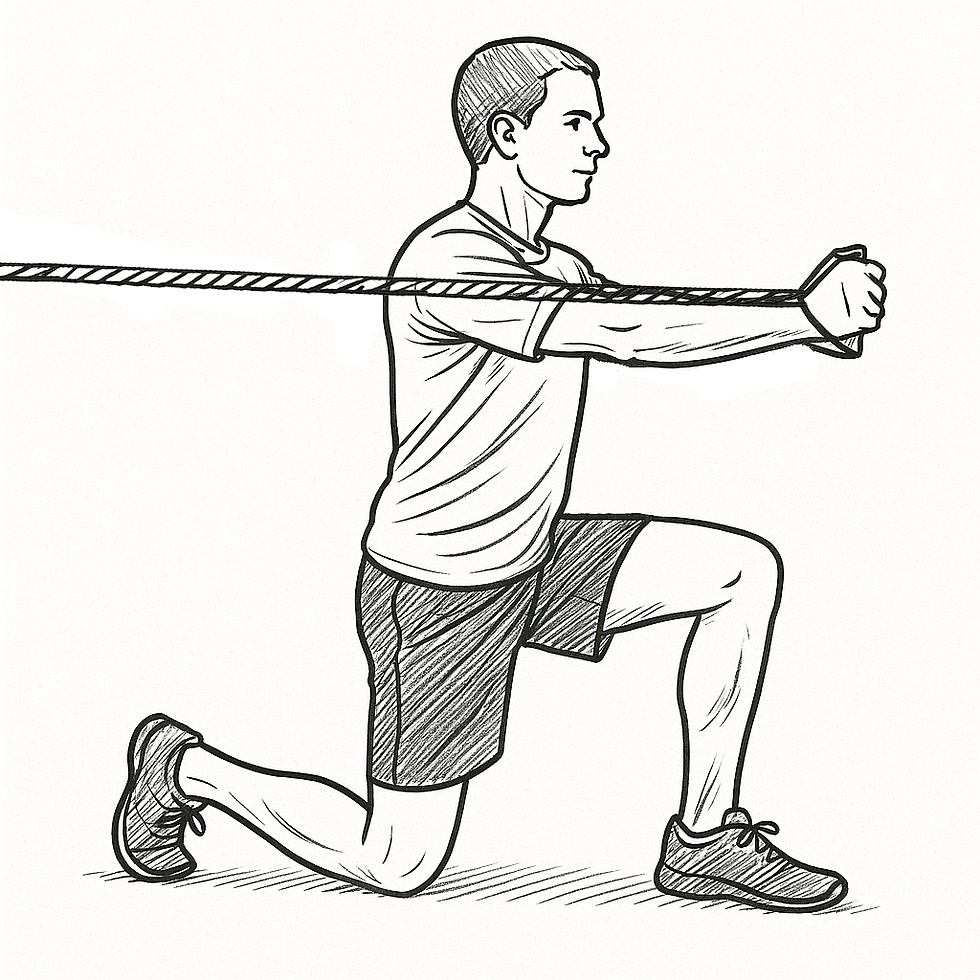Functional Training for Padel: 5 Key Exercises to Elevate Your Game
- Chris Moore
- May 6
- 4 min read

Whether you're a seasoned player or just getting into padel, functional strength is the foundation of athletic success on the court. Unlike traditional gym workouts, functional training focuses on movement patterns that mirror the demands of your sport — helping you move better, react faster, and stay injury-free.
This padel-specific workout is designed to build foundational strength and rotational control — critical for racquet sports. The mechanics translate directly to padel players who lunge, twist, accelerate, and decelerate with every rally. To perform these movements you will need access to a cable-machine or resistance bands.
Workout Format
Structure: Circuit style
Rounds: 3 total
Rest: 60–90 seconds between rounds
Tempo: Controlled movements with focus on form
Exercise | Reps (each side) | Notes |
Kneeling Pallof Press | 10 | Anti-rotation core strength |
Lateral Lunge to Drive | 8 | Lunge in, drive out (power) |
Kneeling Single Arm Press | 10 | Core & shoulder stability |
Kneeling Single Arm Row | 10 | Posterior chain + posture |
Forward Deceleration Lunge | 8 | Quad & trunk control under load |
Exercise Breakdown & Padel Benefits
1. Kneeling Pallof Press

This anti-rotation core exercise trains your trunk to resist force from the side — exactly what you need when reacting to quick lateral shots. The kneeling position also activates the hip on the grounded side, helping stabilize lunge movements.
How to Perform:
Anchor a resistance band at chest height.
Get into a half-kneeling position with the knee closest to the anchor down.
Hold the band with one hand, arm extended forward.
Row the band toward your ribcage by pulling your elbow straight back.
Keep your torso upright and avoid twisting as you pull.
Slowly return to the starting position.
Tip: Engage your glutes and core to resist rotation.
Why it matters for padel: Enhances control during sudden twists and improves core integrity for backhand/forehand transitions.
2. Lateral Lunge with Leg Drive

Mimicking the side-to-side movement of padel, this exercise strengthens the legs while training the body to absorb force and explosively recover. The “drive” portion mimics recovering back to center after a wide shot.
How to Perform:
Anchor the resistance band behind you at chest height.
Kneel with the leg opposite the pressing arm forward.
Hold the band in one hand at chest level.
Press the band straight forward, keeping your body tall and steady.
Slowly return to the start, resisting the band’s pull.
Tip: Keep your shoulder, hip, and knee stacked for full-body stability.
Why it matters for padel: Builds lateral agility and power, improving your ability to reach and return fast balls.
3. Kneeling Single Arm Chest Press

Pressing from a half-kneeling stance challenges your trunk while simulating the reaching and pressing motions used in overhead smashes or volleys.
How to Perform:
Anchor a resistance band at chest height to your side.
Get into a half-kneeling position with the outside knee down (away from the band).
Hold the band with both hands at your chest.
Press your hands straight out in front of you, arms extended.
Hold for 1–2 seconds, then bring hands back to chest.
Tip: Keep your torso and hips square — avoid rotation. This is a core anti-rotation drill.
Why it matters for padel: Develops unilateral control and strengthens the kinetic chain from the ground up — essential for consistent, powerful strokes.
4. Kneeling Single Arm Row

This row variation builds strength in the back and shoulders, while reinforcing posture and balance. Holding the kneeling stance under load also trains trunk stability.
How to Perform:
Stand tall with the band anchored to your side and held at chest level.
Step laterally toward the band, lowering into a deep side lunge.
Load the lunging leg and drive explosively back to center, raising the opposite knee high (sprinter position).
Return to starting position and repeat.
Tip: Absorb into the lunge with control and explode out with power.
Why it matters for padel: Supports shoulder health and prevents injury, especially during repeated serves, smashes, or defensive shots.
5. Forward Deceleration Lunge

This movement focuses on controlling the eccentric phase of a lunge — the “braking” phase that often causes injury when done poorly. It also builds pushing power to return to a ready stance.
How to Perform:
Anchor the resistance band in front of you and hold both handles at your chest.
Step forward into a lunge, allowing the band to pull you slightly forward.
Decelerate by controlling your descent into the lunge.
Push through the front heel to return to standing.
Tip: Maintain a tall posture and avoid letting the front knee collapse inward. This trains eccentric strength and trunk control.
Why it matters for padel: Trains your ability to absorb force and recover quickly, helping you stay balanced and explosive in high-pressure moments.
Final Thoughts
Functional training is about building athleticism that transfers directly to the court. These five exercises — when performed consistently — will improve your movement quality, strength, and game awareness.
As you progress, aim to shorten rest between rounds and increase total volume. Over time, you’ll notice sharper footwork, better recovery between points, and more confident, controlled shots.
Movement matters. Make it functional. Make it count.

Comments